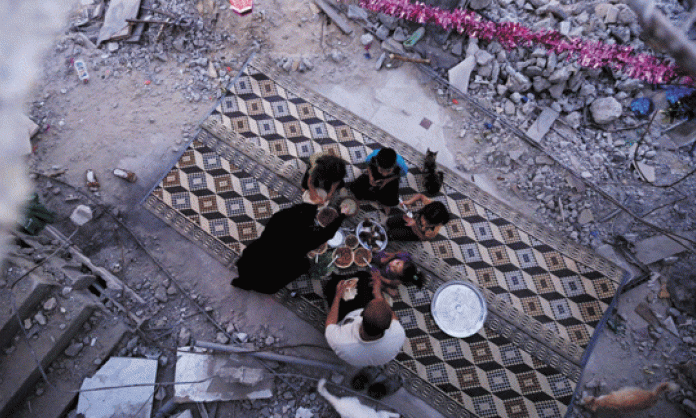“One evening, I noticed that Rahet’s skin had changed colour and I became very scared. She had turned blue.”
In January, the Assi family from Gaza lost their 4-month-old girl to hypothermia. Rahet’s death should be added to the 2,257 Palestinians killed by Israel’s savage military assault on Gaza between July and August 2014. The invasion not only took lives, but also laid waste to the territory’s infrastructure.
After the August cease-fire, the Assi family returned to live in their damaged home. During the January winter storms, rain would pour through the holes in the ceiling and collapsed walls caused by Israeli air strikes. The plastic sheeting covering the blown-out windows proved inadequate for the strong wind. Without electricity or heating, the terrible cold took its toll.
During the Gaza war, Israel systematically targeted family homes. Whole neighbourhoods were flattened, with the apocalyptic scenes from the suburb Shuja’iyya only the most chilling. At the time, the UN high commissioner for human rights, Navi Pillay, pointed out, “What we are witnessing is the killing of entire families”.
Some damaged homes have begun to be repaired, but nearly a year on from the war, the UN Office for the Coordination of Humanitarian Affairs reports, “[N]ot a single destroyed home has been rebuilt”. The basic human right to adequate shelter is denied to an estimated 100,000 people who remain internally displaced in what is the land of permanent refugee camps – 70 percent of Gazans are refugees forcibly expelled from their homes when Israel was established in 1948.
Rahet was also a victim of the crippling economic and military blockade imposed by Israel on the tiny coastal enclave. The failure to rebuild homes, along with dozens of hospitals, schools and other destroyed infrastructure is due to Israel’s blockade. Not enough construction materials are getting through the border crossings. Nor is there enough fuel to fire the Gaza power plant so critical to the functioning of basic services. Hospitals are forced to rely on back-up generators.
The lack of medical supplies and equipment forces more than 1,000 patients a month to seek help in Israeli or West Bank hospitals. But access to specialised health care is dependent on attaining an exit visa from Israel. These are frequently denied or delayed. And despite the occasional easing of restrictions, the majority of Gazans are ineligible for exit visas.
Rolling power outages of up to 12 hours also limit the supply of water to households. It runs for only two or three days a week, keeping per capita water consumption at 60 percent of the minimum recommended by World Health Organisation.
And that’s for those connected to the water network. An estimated 120,000 Gazans remain without a municipal water supply due to unrepaired infrastructure.
For a period, the complex rabbit warren of smuggling tunnels that connect Egypt to Gaza had been a lifeline. These are still open, but they are much diminished. Egypt floods them with sewage, and Israel frequently bombs them from the sky.
Egypt is imposing its own militarised buffer zone along the border with Gaza to strangle the economy further. The Rafah crossing had been opened for only five days this year as of April.
Occupation
Israel extended its grip over Palestinian lives when it seized Gaza from the Egyptians and the West Bank from the Jordanians in the 1967 war. That the West Bank is occupied territory – with its military checkpoints, Israeli-only roads, apartheid wall and 300,000 illegal and mostly armed fanatical settlers – is obvious.
But today Israel maintains that Gaza is no longer occupied. It did remove illegal settlements and permanent military installations in September 2005. At the time, in a speech before the United Nations General Assembly, Israeli prime minister Ariel Sharon announced “the end of Israeli control over and responsibility for the Gaza Strip”.
This was a lie.
Israel controls Palestinian tax revenue, which it has been withholding for months in protest at Palestine’s accession to the International Criminal Court. Thousands of public employees in Gaza go without salaries. Absenteeism is high because workers can’t afford the travel costs to get to work.
Israel controls Gaza’s population registry.
Israel periodically lays waste to Gaza’s already inadequate infrastructure.
Israel has a vice grip on Gaza’s land, sea and air borders.
The aim is to keep the Gazan economy paralysed, stunted and always on the verge of collapse.
Real per capita income is now 31 percent lower than 20 years ago. The unemployment rate is 43 percent. For youth the figure is more than 60 percent. Eighty percent of the population is dependent on some form of international aid.
Food insecurity stands at 73 percent because much of Gaza’s farmland, greenhouses, animal shelters and irrigation systems were destroyed by the 2014 war.
Today farmers risk their lives to tend their land. Since 2012, Israel has imposed a “security buffer zone” along the eastern and northern borders, annexing precious arable land. Israeli military jeeps drive up and down this area shooting at farmers who get anywhere near the buffer zone.
Fishermen face similar obstacles. The 1993 Oslo Accords established the right to fish up to 20 nautical miles off Gaza’s coast. But for years, fishermen have been confined to a mere three nautical miles – the waters most polluted by untreated sewage and where only small fish are to be caught.
The August cease-fire agreement was meant to extend this to six nautical miles, but keeping within this area hasn’t ensured safety. Israeli navy harassment and firing on fishermen is an almost daily occurrence. Three have been shot dead since September, according to the Union of Fishermen.
Fishermen are also arrested and interrogated for days. Others have their boats and nets confiscated and destroyed.
War and occupation have left indelible scars on Gaza’s children. Seven-year-olds in Gaza have lived through three major wars. They have lost scores of family and grieve for those who should be filling the empty chairs in their classrooms. Many will suffer permanent disabilities. Most are traumatised. The UN Children’s Fund (UNICEF) reports that nearly 425,000 children in Gaza are in need of immediate psychosocial support.
The bleak picture in Gaza is a product of Israel’s control over the most basic aspects of daily life. It exposes the lengths Israel will go to in order to crush the Palestinian will to resist.
But resilience and quiet defiance continue. We can see this in the determination of children to return to school and with the families currently breaking their fast during Ramadan amid the rubble of what previously was their home.











